TOYOTA HILUX 2012 Owners Manual (in English)
Manufacturer: TOYOTA, Model Year: 2012, Model line: HILUX, Model: TOYOTA HILUX 2012Pages: 636, PDF Size: 34.38 MB
Page 211 of 636
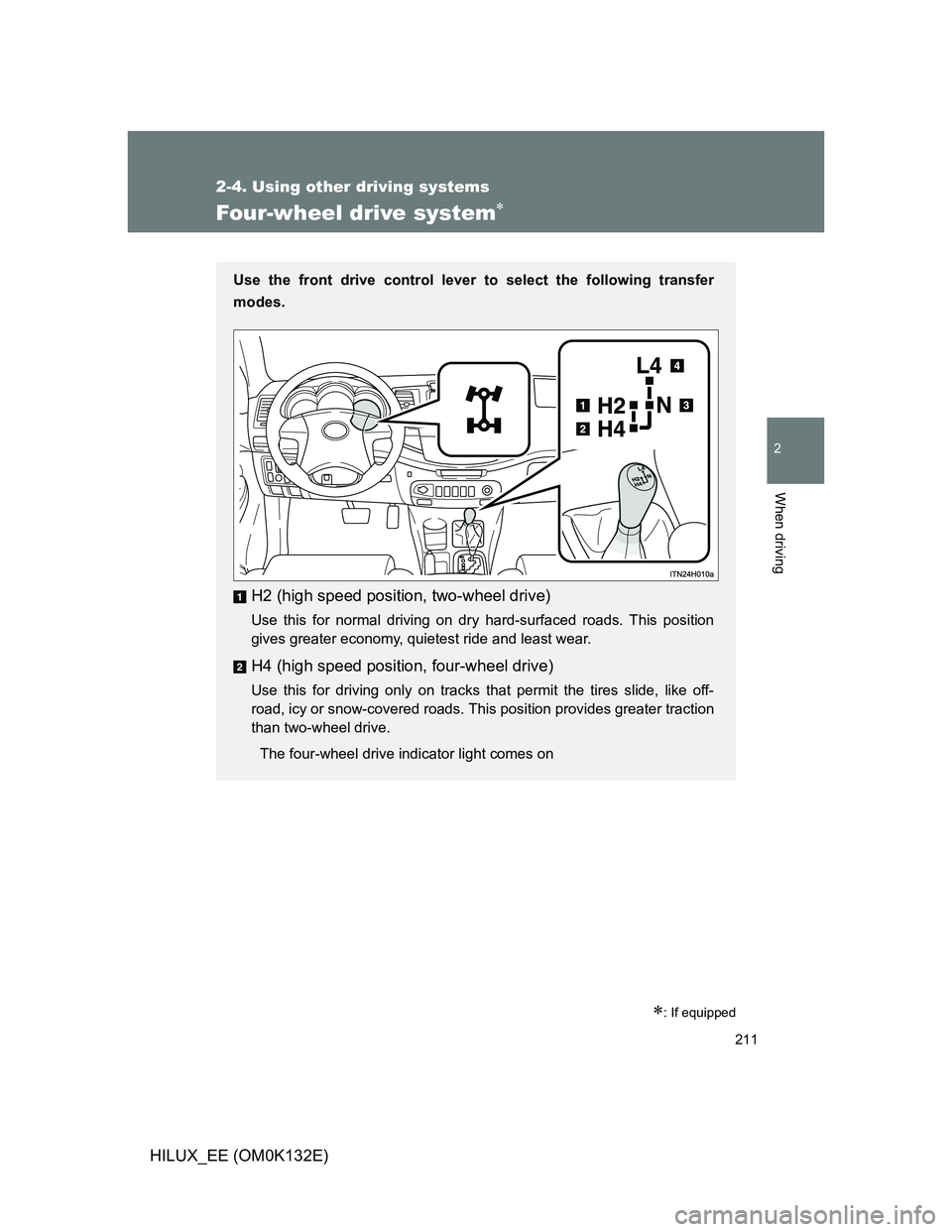
211
2-4. Using other driving systems
2
When driving
HILUX_EE (OM0K132E)
Four-wheel drive system
: If equipped
Use the front drive control lever to select the following transfer
modes.
H2 (high speed position, two-wheel drive)
Use this for normal driving on dry hard-surfaced roads. This position
gives greater economy, quietest ride and least wear.
H4 (high speed position, four-wheel drive)
Use this for driving only on tracks that permit the tires slide, like off-
road, icy or snow-covered roads. This position provides greater traction
than two-wheel drive.
The four-wheel drive indicator light comes on
Page 212 of 636
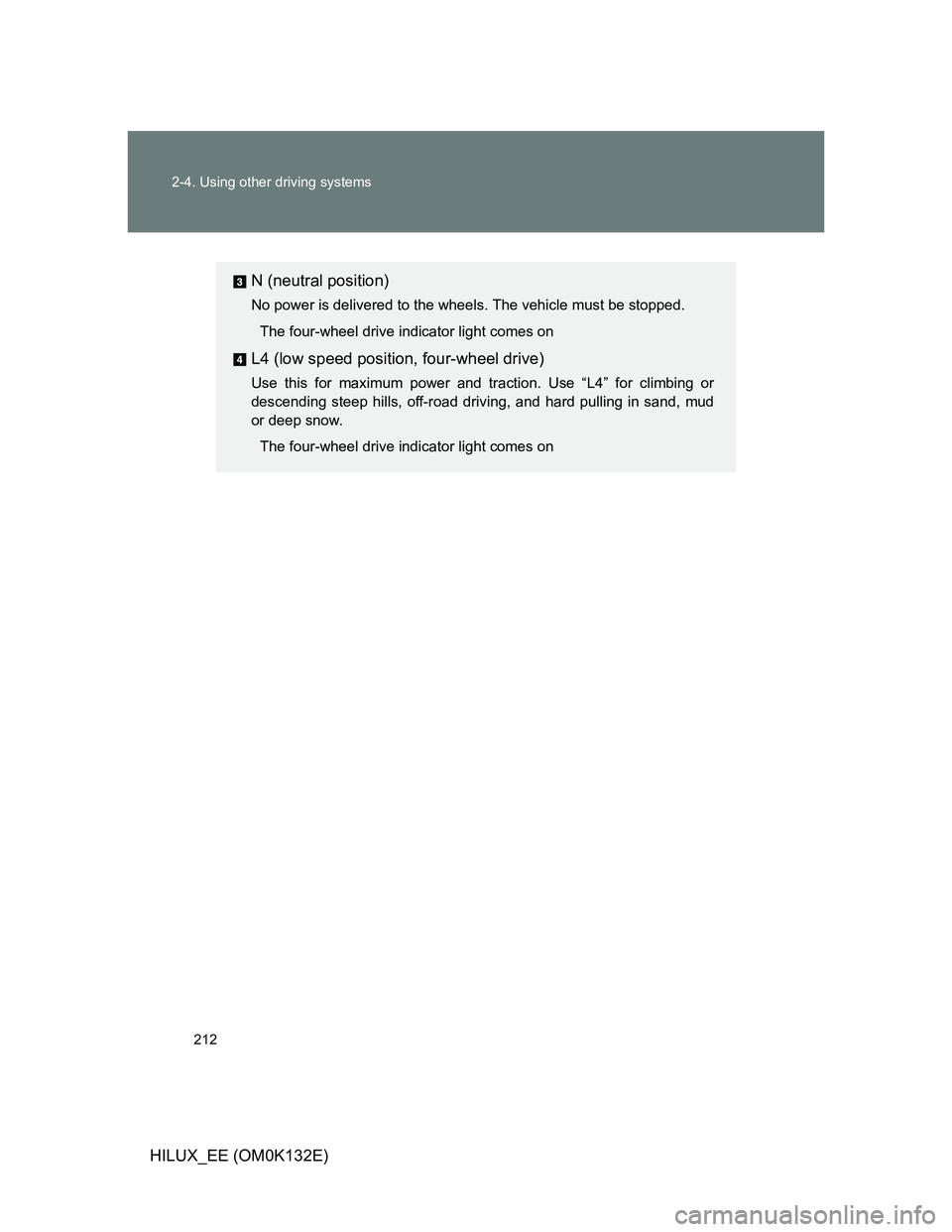
212 2-4. Using other driving systems
HILUX_EE (OM0K132E)
N (neutral position)
No power is delivered to the wheels. The vehicle must be stopped.
The four-wheel drive indicator light comes on
L4 (low speed position, four-wheel drive)
Use this for maximum power and traction. Use “L4” for climbing or
descending steep hills, off-road driving, and hard pulling in sand, mud
or deep snow.
The four-wheel drive indicator light comes on
Page 213 of 636
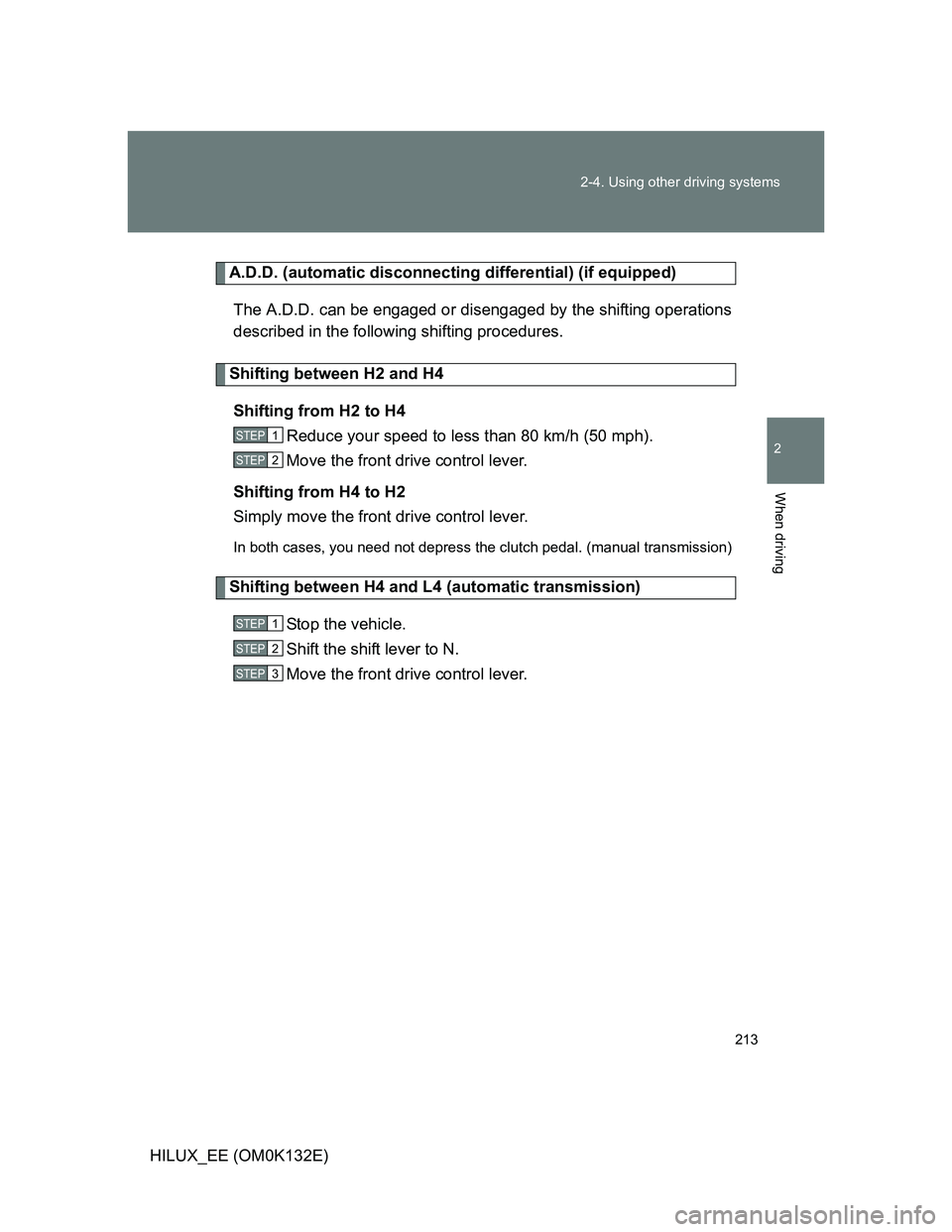
213 2-4. Using other driving systems
2
When driving
HILUX_EE (OM0K132E)
A.D.D. (automatic disconnecting differential) (if equipped)
The A.D.D. can be engaged or disengaged by the shifting operations
described in the following shifting procedures.
Shifting between H2 and H4
Shifting from H2 to H4
Reduce your speed to less than 80 km/h (50 mph).
Move the front drive control lever.
Shifting from H4 to H2
Simply move the front drive control lever.
In both cases, you need not depress the clutch pedal. (manual transmission)
Shifting between H4 and L4 (automatic transmission)
Stop the vehicle.
Shift the shift lever to N.
Move the front drive control lever.
STEP1
STEP2
STEP1
STEP2
STEP3
Page 214 of 636
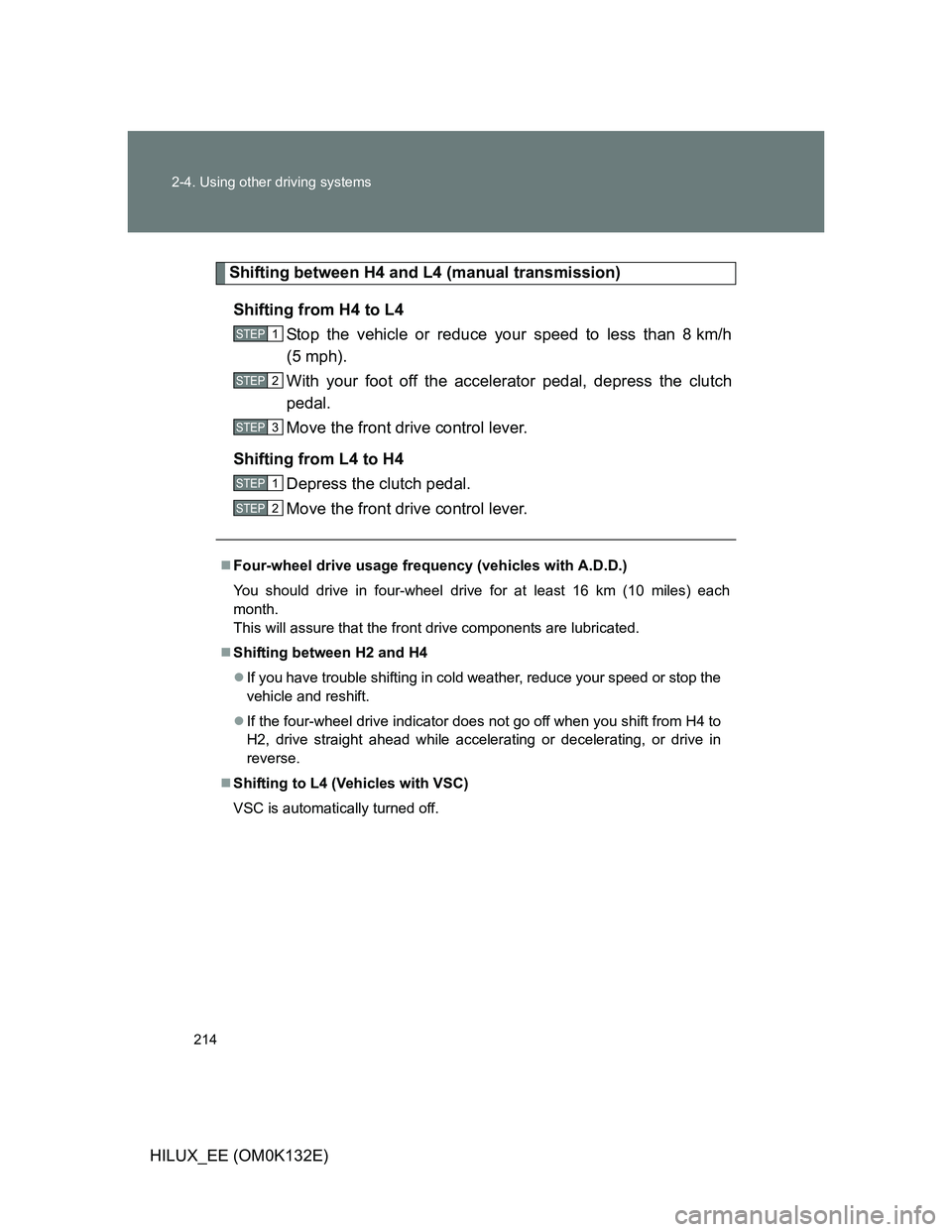
214 2-4. Using other driving systems
HILUX_EE (OM0K132E)
Shifting between H4 and L4 (manual transmission)
Shifting from H4 to L4
Stop the vehicle or reduce your speed to less than 8 km/h
(5 mph).
With your foot off the accelerator pedal, depress the clutch
pedal.
Move the front drive control lever.
Shifting from L4 to H4
Depress the clutch pedal.
Move the front drive control lever.
Four-wheel drive usage frequency (vehicles with A.D.D.)
You should drive in four-wheel drive for at least 16 km (10 miles) each
month.
This will assure that the front drive components are lubricated.
Shifting between H2 and H4
If you have trouble shifting in cold weather, reduce your speed or stop the
vehicle and reshift.
If the four-wheel drive indicator does not go off when you shift from H4 to
H2, drive straight ahead while accelerating or decelerating, or drive in
reverse.
Shifting to L4 (Vehicles with VSC)
VSC is automatically turned off.
STEP1
STEP2
STEP3
STEP1
STEP2
Page 215 of 636
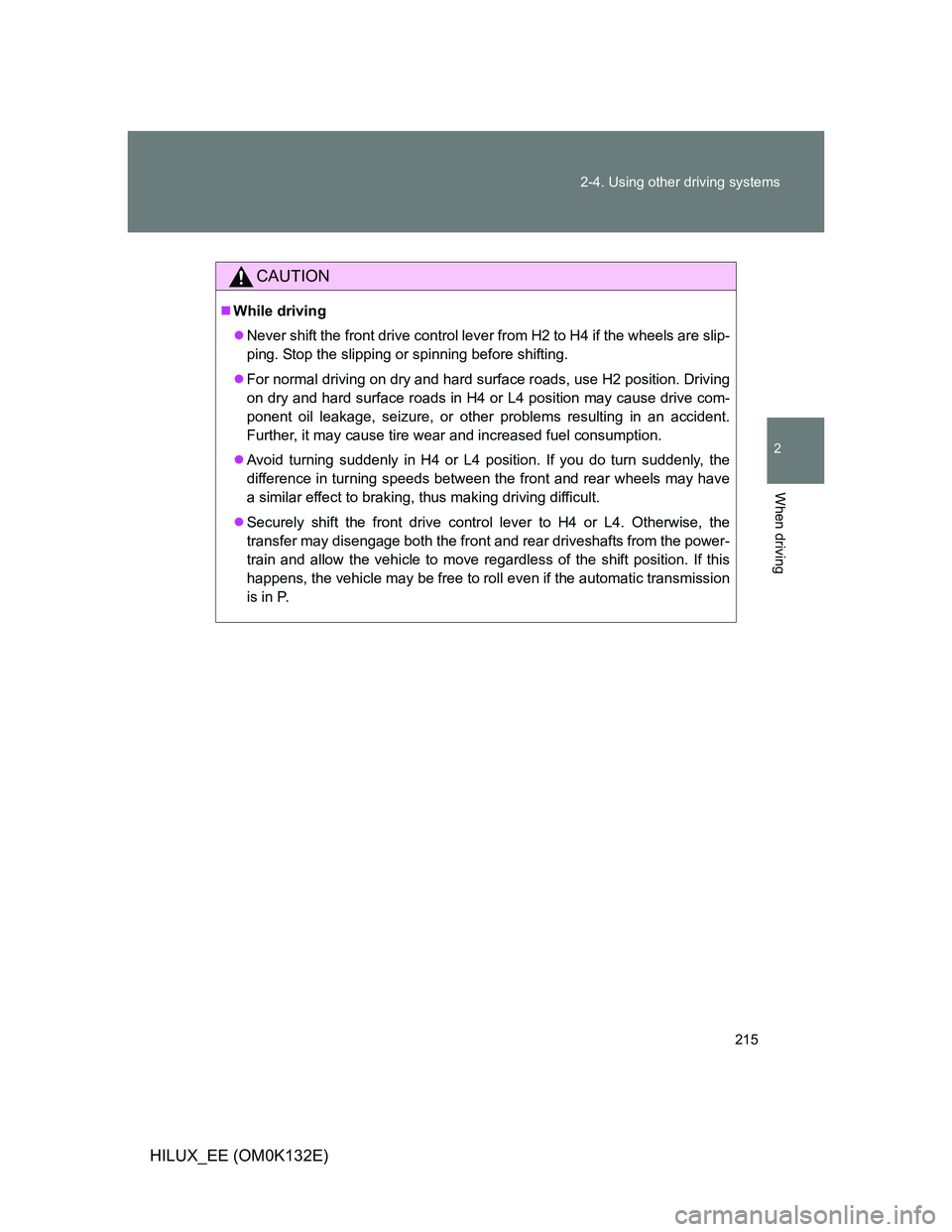
215 2-4. Using other driving systems
2
When driving
HILUX_EE (OM0K132E)
CAUTION
While driving
Never shift the front drive control lever from H2 to H4 if the wheels are slip-
ping. Stop the slipping or spinning before shifting.
For normal driving on dry and hard surface roads, use H2 position. Driving
on dry and hard surface roads in H4 or L4 position may cause drive com-
ponent oil leakage, seizure, or other problems resulting in an accident.
Further, it may cause tire wear and increased fuel consumption.
Avoid turning suddenly in H4 or L4 position. If you do turn suddenly, the
difference in turning speeds between the front and rear wheels may have
a similar effect to braking, thus making driving difficult.
Securely shift the front drive control lever to H4 or L4. Otherwise, the
transfer may disengage both the front and rear driveshafts from the power-
train and allow the vehicle to move regardless of the shift position. If this
happens, the vehicle may be free to roll even if the automatic transmission
is in P.
Page 216 of 636
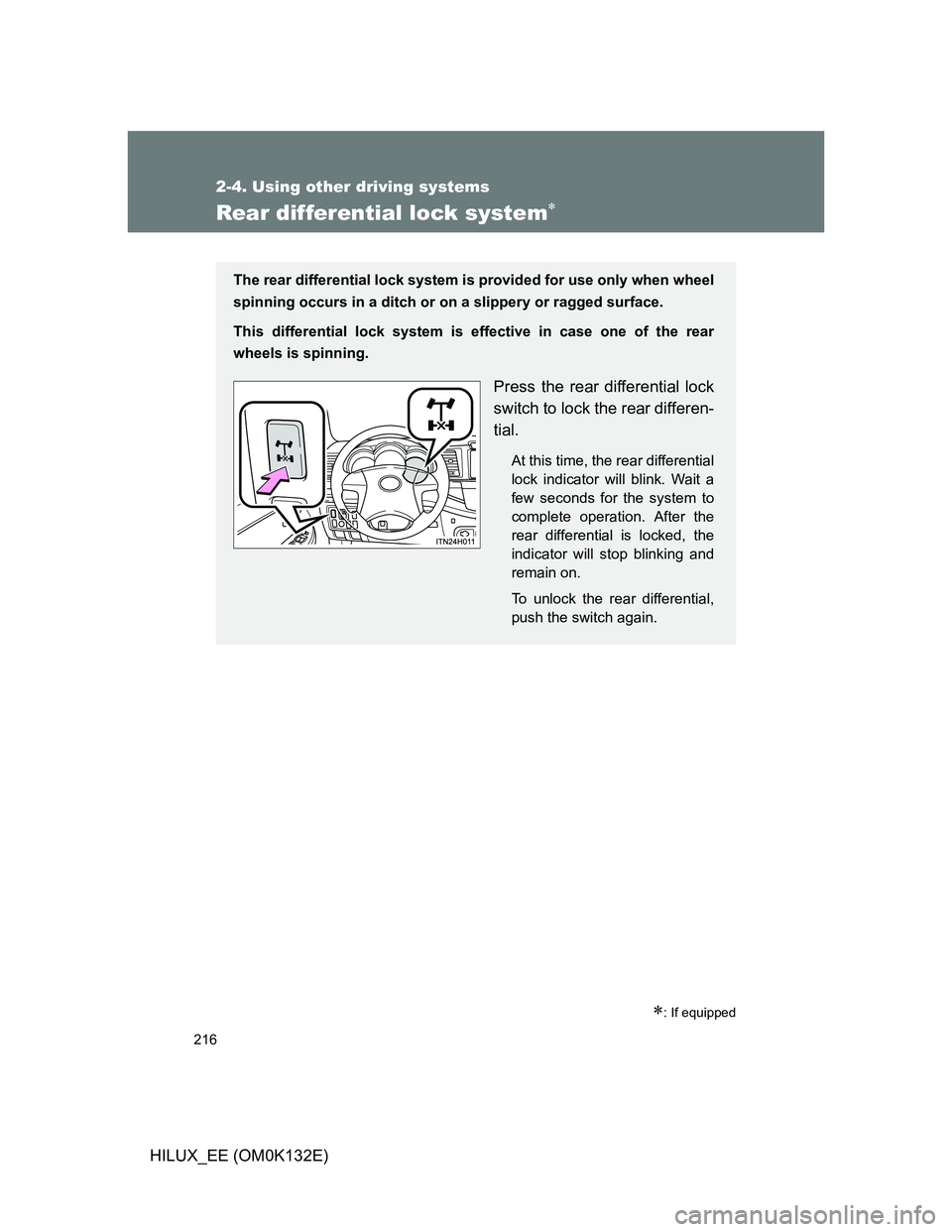
216
2-4. Using other driving systems
HILUX_EE (OM0K132E)
Rear differential lock system
: If equipped
The rear differential lock system is provided for use only when wheel
spinning occurs in a ditch or on a slippery or ragged surface.
This differential lock system is effective in case one of the rear
wheels is spinning.
Press the rear differential lock
switch to lock the rear differen-
tial.
At this time, the rear differential
lock indicator will blink. Wait a
few seconds for the system to
complete operation. After the
rear differential is locked, the
indicator will stop blinking and
remain on.
To unlock the rear differential,
push the switch again.
Page 217 of 636
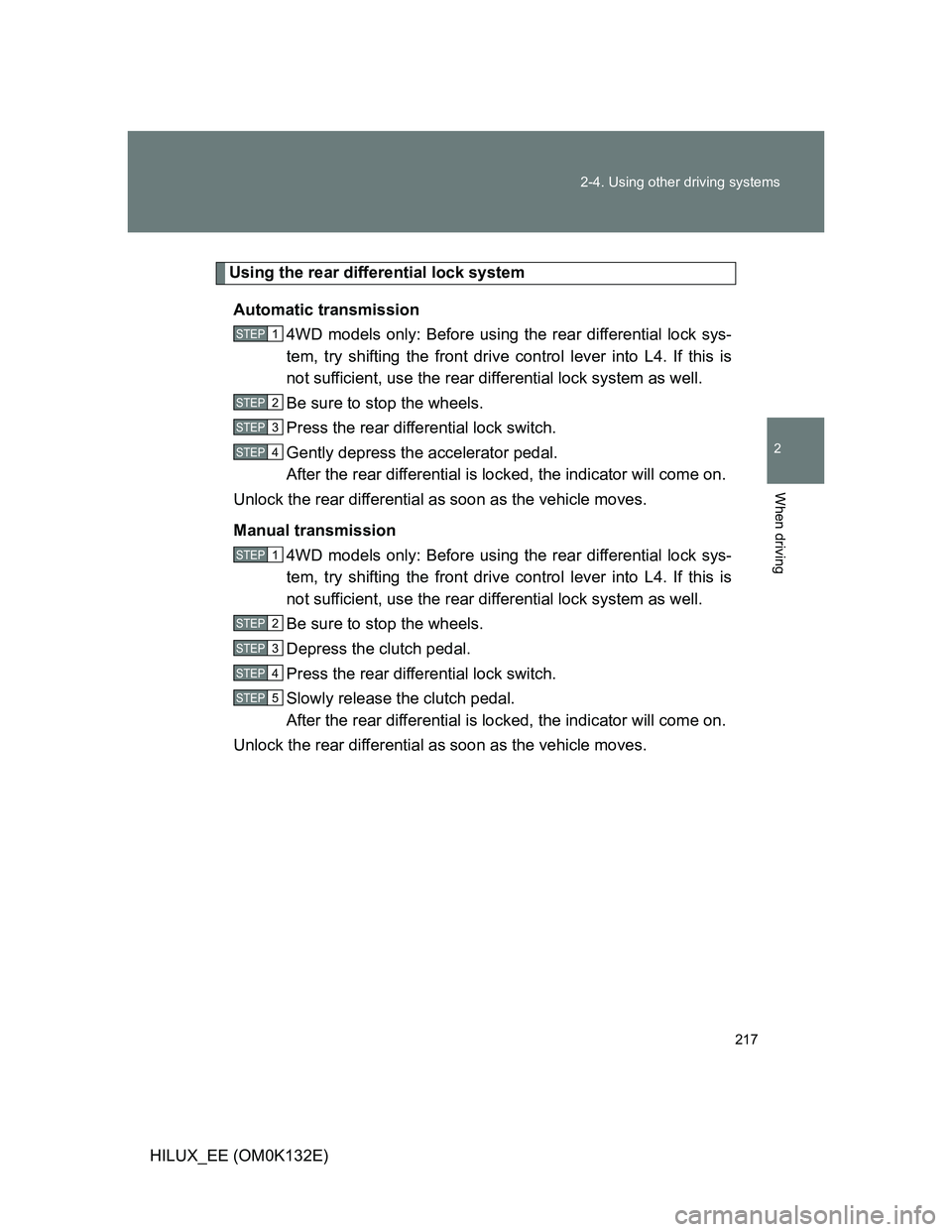
217 2-4. Using other driving systems
2
When driving
HILUX_EE (OM0K132E)
Using the rear differential lock system
Automatic transmission
4WD models only: Before using the rear differential lock sys-
tem, try shifting the front drive control lever into L4. If this is
not sufficient, use the rear differential lock system as well.
Be sure to stop the wheels.
Press the rear differential lock switch.
Gently depress the accelerator pedal.
After the rear differential is locked, the indicator will come on.
Unlock the rear differential as soon as the vehicle moves.
Manual transmission
4WD models only: Before using the rear differential lock sys-
tem, try shifting the front drive control lever into L4. If this is
not sufficient, use the rear differential lock system as well.
Be sure to stop the wheels.
Depress the clutch pedal.
Press the rear differential lock switch.
Slowly release the clutch pedal.
After the rear differential is locked, the indicator will come on.
Unlock the rear differential as soon as the vehicle moves.
STEP1
STEP2
STEP3
STEP4
STEP1
STEP2
STEP3
STEP4
STEP5
Page 218 of 636
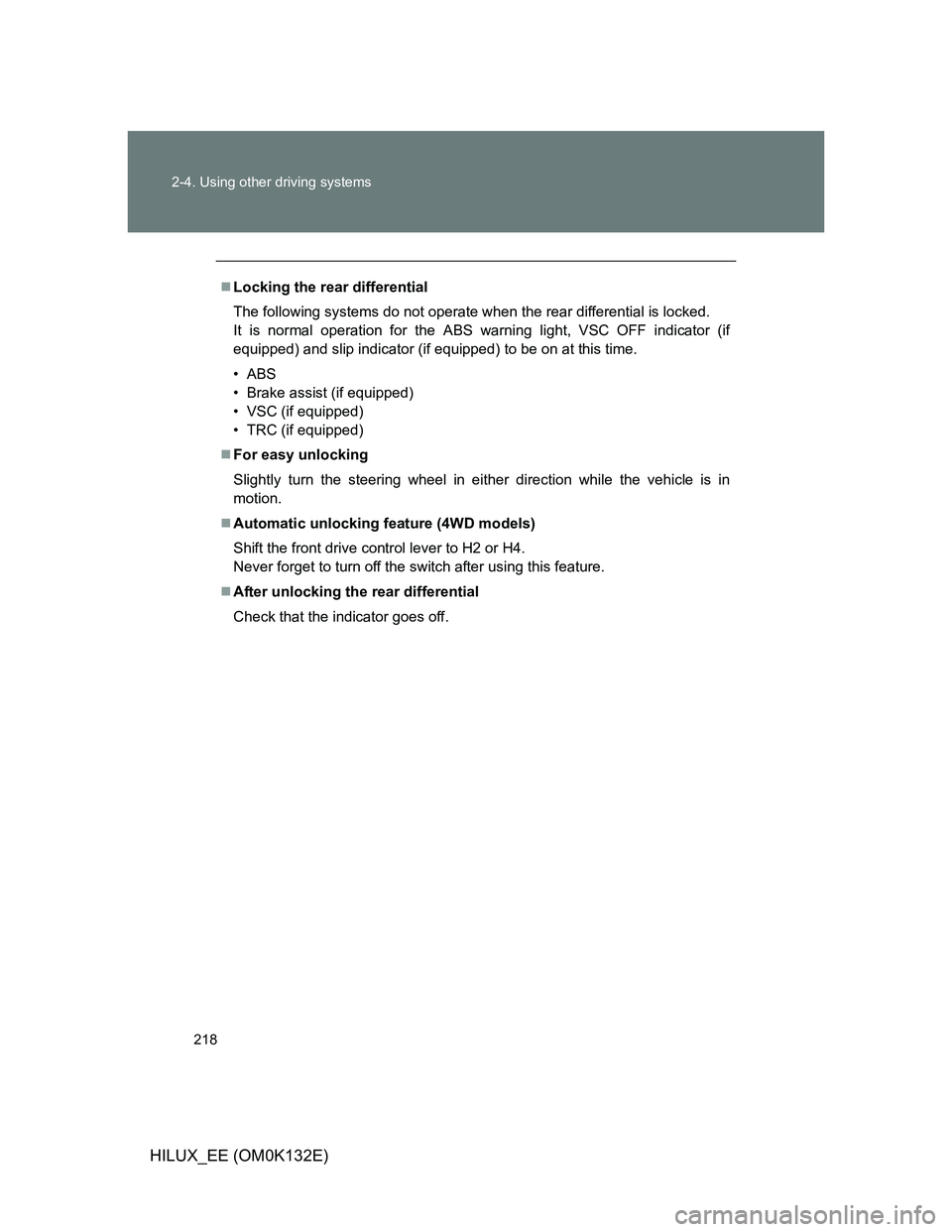
218 2-4. Using other driving systems
HILUX_EE (OM0K132E)
Locking the rear differential
The following systems do not operate when the rear differential is locked.
It is normal operation for the ABS warning light, VSC OFF indicator (if
equipped) and slip indicator (if equipped) to be on at this time.
•ABS
• Brake assist (if equipped)
• VSC (if equipped)
• TRC (if equipped)
For easy unlocking
Slightly turn the steering wheel in either direction while the vehicle is in
motion.
Automatic unlocking feature (4WD models)
Shift the front drive control lever to H2 or H4.
Never forget to turn off the switch after using this feature.
After unlocking the rear differential
Check that the indicator goes off.
Page 219 of 636
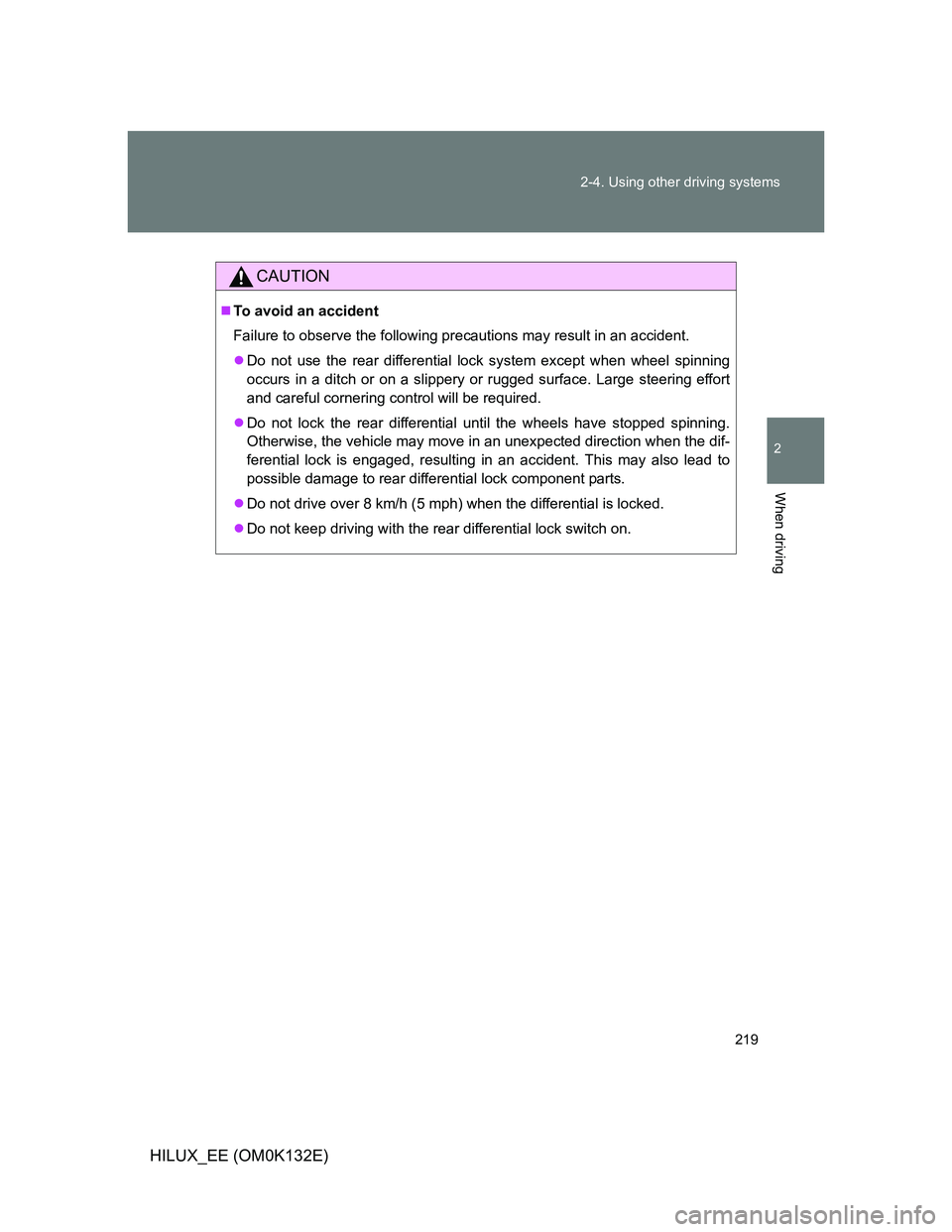
219 2-4. Using other driving systems
2
When driving
HILUX_EE (OM0K132E)
CAUTION
To avoid an accident
Failure to observe the following precautions may result in an accident.
Do not use the rear differential lock system except when wheel spinning
occurs in a ditch or on a slippery or rugged surface. Large steering effort
and careful cornering control will be required.
Do not lock the rear differential until the wheels have stopped spinning.
Otherwise, the vehicle may move in an unexpected direction when the dif-
ferential lock is engaged, resulting in an accident. This may also lead to
possible damage to rear differential lock component parts.
Do not drive over 8 km/h (5 mph) when the differential is locked.
Do not keep driving with the rear differential lock switch on.
Page 220 of 636
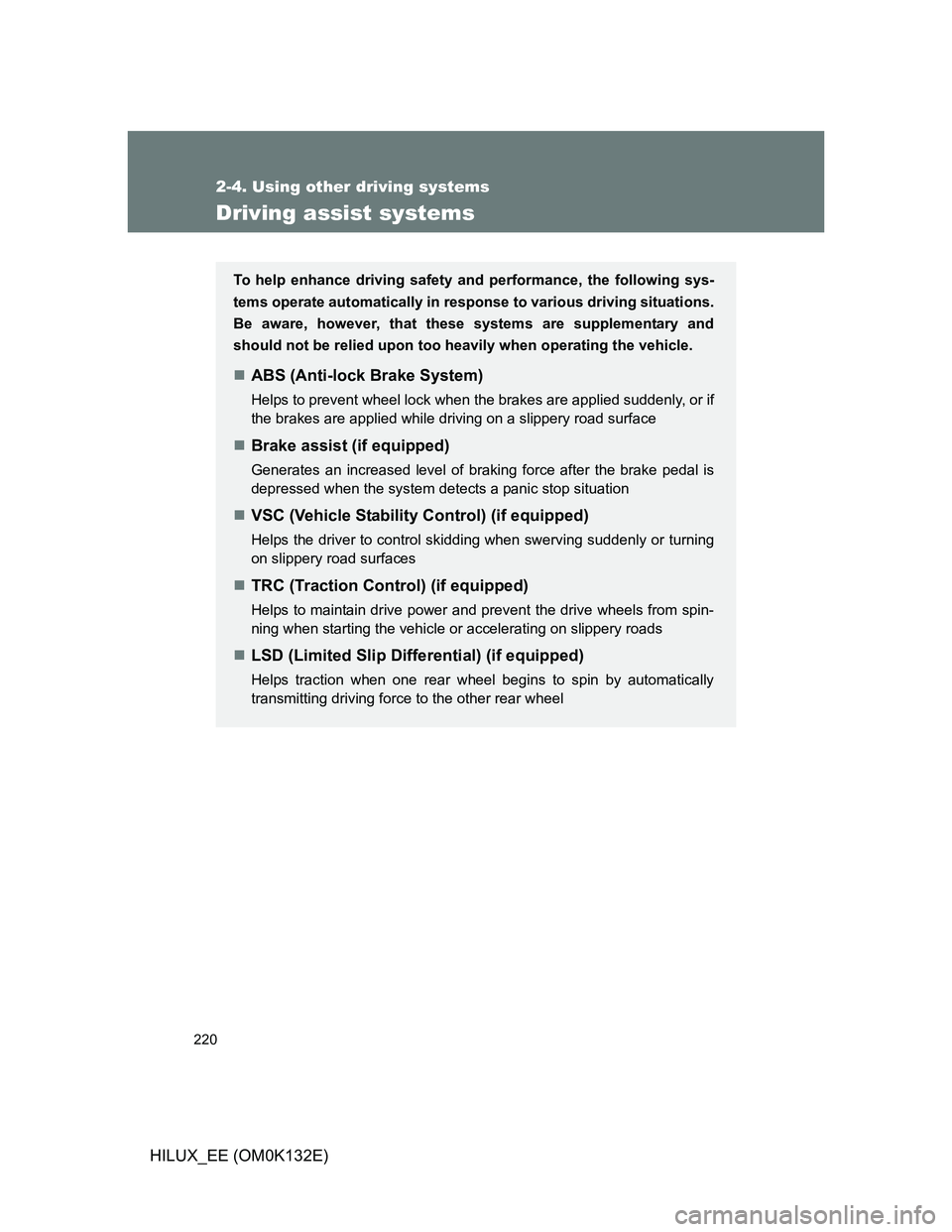
220
2-4. Using other driving systems
HILUX_EE (OM0K132E)
Driving assist systems
To help enhance driving safety and performance, the following sys-
tems operate automatically in response to various driving situations.
Be aware, however, that these systems are supplementary and
should not be relied upon too heavily when operating the vehicle.
ABS (Anti-lock Brake System)
Helps to prevent wheel lock when the brakes are applied suddenly, or if
the brakes are applied while driving on a slippery road surface
Brake assist (if equipped)
Generates an increased level of braking force after the brake pedal is
depressed when the system detects a panic stop situation
VSC (Vehicle Stability Control) (if equipped)
Helps the driver to control skidding when swerving suddenly or turning
on slippery road surfaces
TRC (Traction Control) (if equipped)
Helps to maintain drive power and prevent the drive wheels from spin-
ning when starting the vehicle or accelerating on slippery roads
LSD (Limited Slip Differential) (if equipped)
Helps traction when one rear wheel begins to spin by automatically
transmitting driving force to the other rear wheel